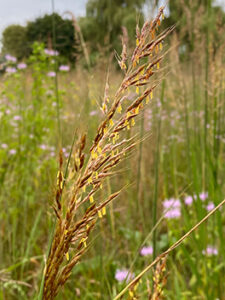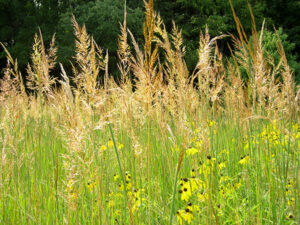NATIVES TO KNOW
Indian Grass – Sorghastrum nutans
By Joyce Tuharsky, WORC Secretary
Autumn is approaching, and now is good time to consider how native grasses can add color and interest to your garden.
 Indian Grass (Sorghastrum nutans) is a showy native perennial that grows 3-7 feet tall and is noted for its upright form and broad blue-green foliage. Its alternate blades grow to 2′ long and 1/2″ across, are flat and hairless, yet rough in texture, and are pointed at the end. During late summer, the plant bears narrow, greatly branched flower panicles (up to 12’’ long) atop stiff vertical stems that rise well above the foliage. Each floret has 3 yellow stamens and 2 white stigmas. The spikelets that bear the florets are fringed with white hairs that give a metallic golden sheen to the flowering parts. These later develop into large, plume-like, seed heads of a soft, golden-brown. In autumn, the color of Indian grass can range from deep orange to purple and usually retains hints of color into the Winter.
Indian Grass (Sorghastrum nutans) is a showy native perennial that grows 3-7 feet tall and is noted for its upright form and broad blue-green foliage. Its alternate blades grow to 2′ long and 1/2″ across, are flat and hairless, yet rough in texture, and are pointed at the end. During late summer, the plant bears narrow, greatly branched flower panicles (up to 12’’ long) atop stiff vertical stems that rise well above the foliage. Each floret has 3 yellow stamens and 2 white stigmas. The spikelets that bear the florets are fringed with white hairs that give a metallic golden sheen to the flowering parts. These later develop into large, plume-like, seed heads of a soft, golden-brown. In autumn, the color of Indian grass can range from deep orange to purple and usually retains hints of color into the Winter.
Many insects, including caterpillars and grasshoppers, feed on Indian Grass. These in turn are an important source of food for many songbirds and upland game birds. Other birds and small mammals eat the grass seeds. Because of its height and tendency to remain erect, Indian Grass provides excellent nesting, escape, and winter cover for wildlife. Throughout the summer when the leaves are green, Indian Grass is relished by livestock and bison, providing a good source of protein and vitamin A.
 Indian Grass was one of the dominant prairie grasses which once covered large parts of the Midwest (along with Big Bluestem, Little Bluestem, and Switch Grass). It appears to be favored by burning and occasional flooding, sometimes forming nearly pure stands in the lowlands. In northern latitudes, Indian Grass may not be as plentiful as other grasses. However, in southern states, it can comprise over 90 percent of a stand. In Michigan, Indian Grass is found primarily in the southern half of the Lower Peninsula.
Indian Grass was one of the dominant prairie grasses which once covered large parts of the Midwest (along with Big Bluestem, Little Bluestem, and Switch Grass). It appears to be favored by burning and occasional flooding, sometimes forming nearly pure stands in the lowlands. In northern latitudes, Indian Grass may not be as plentiful as other grasses. However, in southern states, it can comprise over 90 percent of a stand. In Michigan, Indian Grass is found primarily in the southern half of the Lower Peninsula.
Indian Grass is a clump grass, which means that it grows as singular plants in tufts, rather than forming a sod or lawn. Such grasses have long roots that can reach moisture more deeply than other grasses during drought. These long roots also aid in slope stabilization, erosion control, and soil porosity. Therefore, Indian Grass is often used for re-vegetation of disturbed areas. Other uses include tall grass prairie restorations, wildlife habitats, animal forage and farm management.
On residential properties, Indian Grass can be planted in mass or blended into naturalized areas. It can also be used as vertical accents along garden borders. It grows easily from seed with no pre-treatment necessary, and various kinds of soil are tolerated. Plant in full to partial sun, and water regularly but do not over water; although periods of flooding ordrought are tolerated. Do not cut back in fall because of its winter interest. The flowers of Indian Grass are good for drying and preserving.
More information and photos are available at:
https://www.wildflower.org/gallery/result.php?id_image=24688
https://www.illinoiswildflowers.info/grasses/plants/ind_grass.htm
https://plants.usda.gov/home/plantProfile?symbol=SONU2
Photos by Ruth Oldenburg
